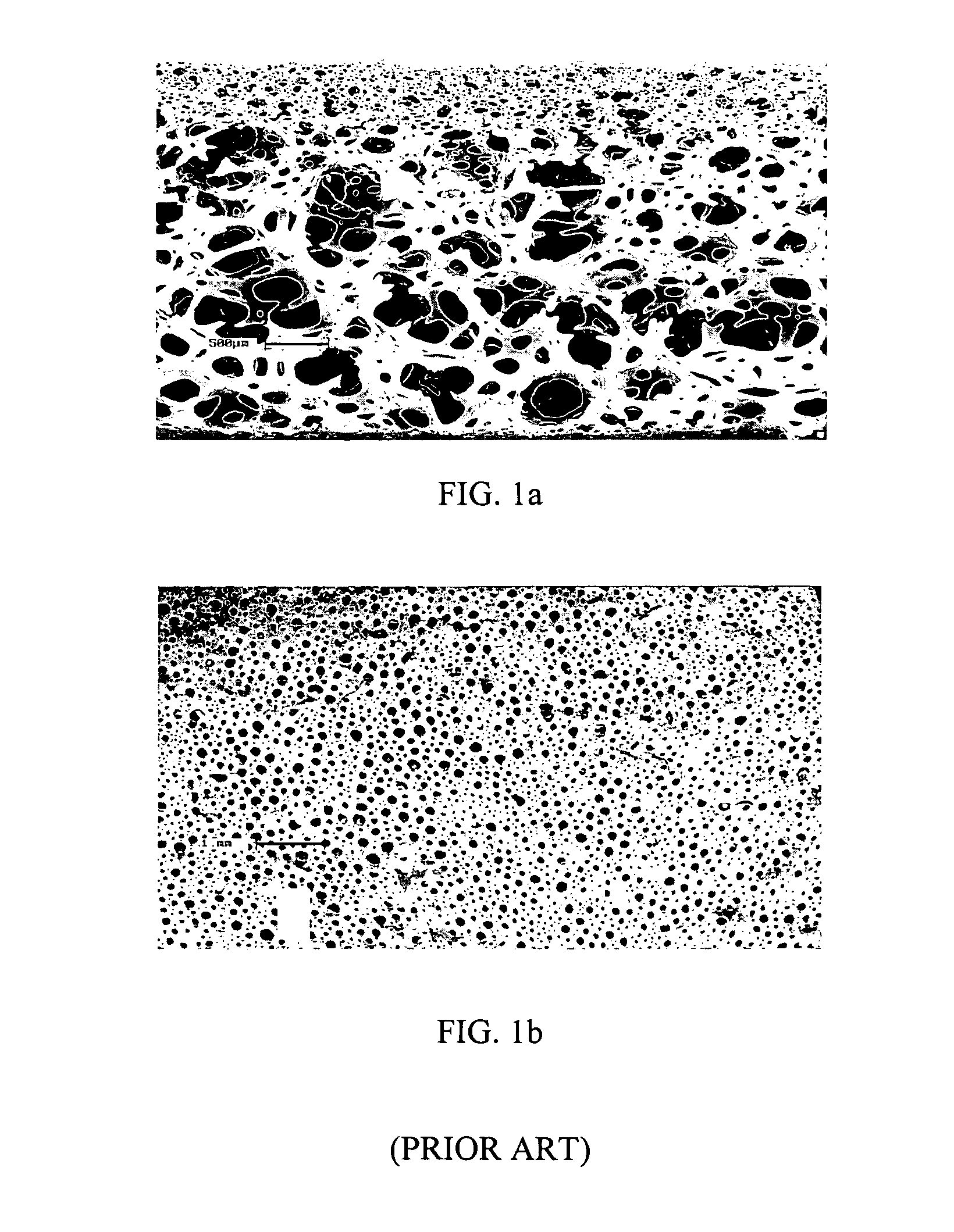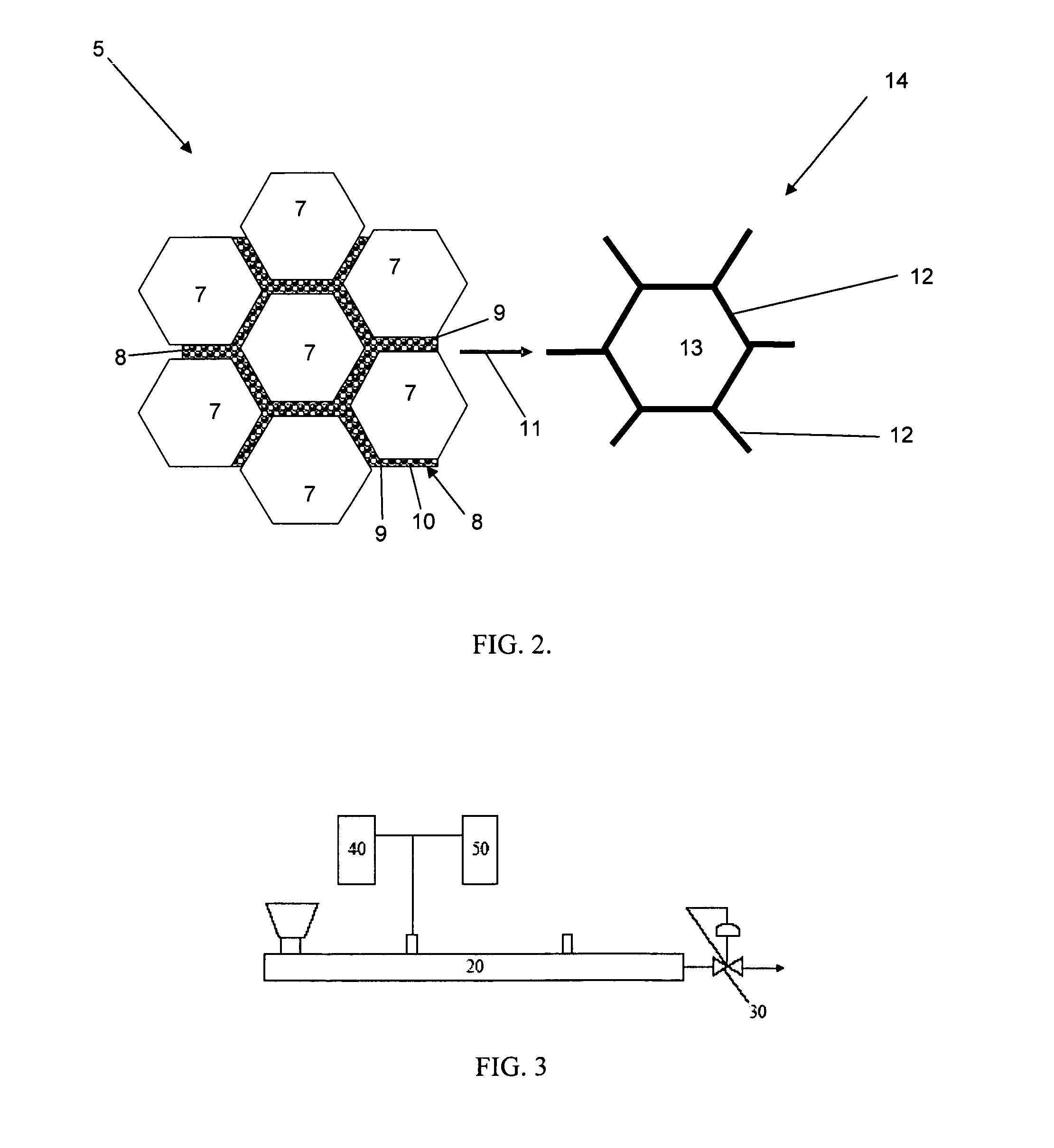Fibrillated polyolefin foam
a technology of foam and polyolefin, applied in the field of production of polyolefin foam, can solve the problems of limited stability and resiliency of air-lay materials, high density of wet laid materials, and high bulk of air-lay materials
- Summary
- Abstract
- Description
- Claims
- Application Information
AI Technical Summary
Benefits of technology
Problems solved by technology
Method used
Image
Examples
example 1
[0132]Three foam samples are prepared according to the above procedure. Sample 1 foam contains no fibers and uses the above described 2-1-1 dispersion of AFFINITY™ EG 8200 (POD 8102, The Dow Chemical Company, Midland, Mich.) and 1.5% STEOL® based on polymer solids. Samples 2 and 3 use a 40% fiber loading with polyethylene fibers (Polyethylene Fiber Type E available from MiniFIBERS, Inc., Johnson City, Tenn.), in addition to the 1.5% STEOL®, both based on polymer solids. Sample 2 is made with 2-1-1 POD 8102 dispersion whereas Sample 3 uses a 2-1-2 POD 8102 dispersion.
[0133]Strike through experiments, testing the speed at which a liquid passes through the foam structure, and Absorbent Capacity Index (ACI) measurements are carried out on these foam samples prepared in accordance with the details disclosed above.
[0134]The liquid used for the strike through measurements is a 5.0 mL sample of synthetic urine (as described in U.S. Pat. No. 5,260,345) at 23° C. with a foam sample size of 50...
example 2
[0140]Foam samples are synthesized in accordance with the protocol outlined above. Polyolefin dispersions (POD 8102) are variably diluted and incorporate varied fiber loadings with polyethylene pulp (Polyethylene Fiber Type E available from MiniFIBERS, Inc., Johnson City, Tenn.). Fiber loadings shown in Table 3 are based upon the weight of polymer solids. Sample foams are 15.3 cm×10.2 cm. These samples are subjected to 45 Degree Run-off test carried out by placing the foam sample on a surface at a 45 degree angle and introducing two 80 mL liquid insults to the top of the foam, and collecting and measuring the quantity of any liquid run-off not absorbed by the foam. The liquid insults are introduced five minutes apart, and the run-off measurements are reported as 1st and 2nd Run-off, respectively. The foam collapse represents the amount of froth collapse during curing. The liquid insult is synthetic urine formulated as 0.03 weight percent calcium chloride, 0.08 weight percent magnesi...
example 3
[0143]SEM images of samples of polyolefin foams made in accordance with the above outlined protocol are illustrated in FIGS. 4a and 4b. The foam formed from an aqueous dispersion of AFFINITY™ with incorporated polyolefin fibers displays a novel, non-cellular, fibrillated structure. The morphology of the foams may be characterized as having a high degree of randomness and larger surface openings as compared to the traditional PFFs shown in FIGS. 1a-b. The cross-section of the foam shown in FIG. 4a also displays a non-cellular architecture with non-woven fibrils and large void spaces. The larger surface openings, as shown in FIG. 4b, may allow for faster liquid strike through and the larger void spaces may result in lower capillary pressure for liquid retention.
[0144]High resolution SEM images of the foam struts show that the polyethylene fibers are substantially encapsulated by the AFFINITY™ polymer, as shown in FIGS. 5 and 6. In FIG. 5, a high resolution image of a strut in the foam...
PUM
| Property | Measurement | Unit |
|---|---|---|
| length | aaaaa | aaaaa |
| weight percent | aaaaa | aaaaa |
| thickness | aaaaa | aaaaa |
Abstract
Description
Claims
Application Information
 Login to View More
Login to View More - R&D
- Intellectual Property
- Life Sciences
- Materials
- Tech Scout
- Unparalleled Data Quality
- Higher Quality Content
- 60% Fewer Hallucinations
Browse by: Latest US Patents, China's latest patents, Technical Efficacy Thesaurus, Application Domain, Technology Topic, Popular Technical Reports.
© 2025 PatSnap. All rights reserved.Legal|Privacy policy|Modern Slavery Act Transparency Statement|Sitemap|About US| Contact US: help@patsnap.com



